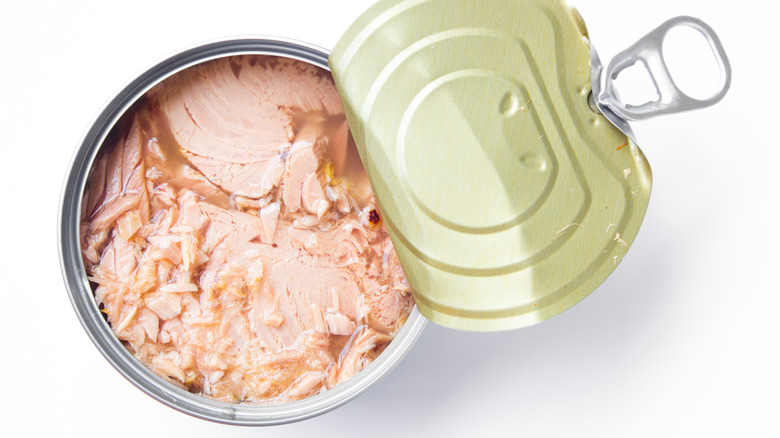
BY SARA LEBOW
Across the United States of America, canned tuna is a popular staple due to its affordability, high nutritional value, and lasting shelf life. Canned tuna makes for a great ingredient in meals like pasta and casserole, the perfect filling for a sandwich, or even a quick snack straight out of the tin. Of course, it's also the staple ingredient of a great tuna salad.
A trip to the grocery store will reveal that when it comes to this canned fish, there are numerous companies and varieties to choose from, including chunk tuna, solid tuna, albacore tuna, white tuna, and even bagged canned tuna (confusing, we know). If you plan on stocking up on some canned tuna on your next shopping trip, there are a few things you should know regarding where canned tuna comes from, what canned tuna's history is, and why it's a popular pantry item. Read on to find out more exciting information about this common lunch box staple.
Expensive canned tuna doesn't necessarily mean it's sustainably caught
Just like a lot of other foods, how expensive canned tuna is in the stores can be more or less a marketing ploy. Simply grabbing the can of tuna with the highest price tag could be a mistake for environmentally-conscious shoppers. There are other ways of telling if your canned tuna is sustainably caught, such as making sure to buy the correct variety of tuna and doing a little research on the company to ensure the tuna is not over-fished from endangered populations.
As it turns out, "pole and line" fishing and "trolling" are two sustainable methods for catching tuna because they're the closest methods to one fisherman with a rod catching tuna. And while these methods can yield expensive results, an expensive can of tuna does not automatically mean the tuna was caught with these more sustainable methods. That tuna may just have a fancy sticker and a great marketing campaign behind its higher price tag.
People have been canning tuna for over 100 years
People have been canning tuna for a long time, maybe longer than you would expect! Tuna canning became popular in the United States of America in the early 1900s as companies were looking for a substitute for tinned sardines. Very quickly, canned tuna became one of the most popular preserved meat products for American consumers, with about 300 million pounds of the canned ocean fish imported into the United States each year. Most canned tuna comes from Asia, including Thailand, Indonesia, Vietnam, and the Philippines, but some canned tuna is also shipped to the United States from South American countries like Ecuador.
Tuna is not generally caught or packaged domestically, within the United States, because the fish is not super available in the nearby oceans. As it turns out, tuna's original success with American consumers came because as a fish, it does not actually have a particularly "fishy" taste, and its white color is more reminiscent of chicken.
Canned tuna has omega-3 fatty acids
Fish is popular with American consumers in part because the food has a high volume of omega-3 fatty acids. Omega-3 fatty acids are beneficial for many reasons. Omega-3 fatty acids have been shown to improve eye and brain health, reduce the risk of heart disease, fight inflammation, and may even prevent against mental health issues like depression, anxiety, and ADHD.
That said, if you're looking to take in the highest concentration of omega-3 fatty acids, you may be better off sticking with another fish like sardines or salmon, or better yet simply taking the omega-3 fatty acids as daily fish oil supplements. Sardines and salmon have a higher concentration of omega-3 fatty acids than tuna, and thus may have more health benefits for consumers. Tuna still has some omega-3 fatty acids, however, and the fish has other health benefits beyond those fatty acids.
Overall, canned tuna is a really healthy food at a low price

Although canned tuna may not have as many omega 3 fatty acids as some of the other fish it shares the ocean with, tuna can be a great source of vitamin D, which might be hard to find if you live someplace that doesn't get much sunshine. Additionally, tuna has a low-fat concentration, low cholesterol, and low-sodium, though some people may assume otherwise because of the saltiness of the ocean.
For its nutritional value, tuna is also relatively inexpensive. One can of tuna is generally less than two bucks and you might even be able to stretch a single can for two meals. And unlike canned beef or pork products, canned tuna is going to offer a higher nutrient-to-cost ratio. Plus, we're betting it'll taste a lot better than some of those other carcinogenic canned meats. Canned tuna certainly isn't gourmet, but if you're on a budget it's definitely not a bad idea to throw a few cans in your grocery cart.
Source from: mashed.com